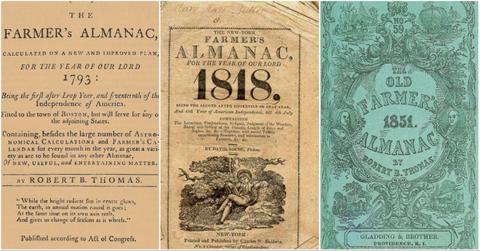Exploring the Difference Between the 'Farmers' Almanac' and the 'Old Farmer’s Almanac'
They both predict the weather, but only one keeps its formula locked in a tin box.
Published Nov. 7 2025, 12:03 p.m. ET

If you’ve ever stood in a checkout line and spotted two nearly identical-looking publications promising weather forecasts, gardening tips, and life advice, you’re not alone. The names are so similar — Farmers’ Almanac and Old Farmer’s Almanac — that it’s easy to assume they’re just two versions of the same thing. But they’re not.
In fact, understanding the difference between the Farmers’ Almanac and the Old Farmer’s Almanac means digging into two separate histories, two editorial voices, and two unique approaches to long-range weather predictions. While both publications have stood the test of time, they each offer something slightly different.

The publisher of the 'Old Famer's Almanac'
Is there actually a difference between the 'Farmers' Almanac' and the 'Old Farmer’s Almanac'?
Yes — they’re entirely separate publications, produced by different companies, with their own editors, styles, and forecasting methods. Farmers’ Almanac (without “Old”) is published by Geiger in Lewiston, Maine. The Old Farmer’s Almanac is published by Yankee Publishing in Dublin, N.H.
Despite having similar names and overlapping content categories — like weather predictions, gardening tips, moon phases, and home remedies — these two almanacs are not affiliated. They were founded nearly a century apart and have grown their own distinct fanbases.
The confusion isn’t surprising. Both come out annually. Both claim remarkably accurate long-range forecasts. And both package their wisdom with a dash of old-school charm. Under the surface, however, they are very different.
The 'Farmers' Almanac' has a distinct editorial voice and forecasting method.
First published in 1818, the Farmers' Almanac aims to offer practical advice for everyday life, with a tone that’s informal, direct, and often humorous. According to Farmers' Almanac's website, its content focuses on “living naturally,” with features on frugal living, home hacks, and folk wisdom in addition to its weather predictions.
Its long-range forecasts are based on a secret formula that’s been passed down from editor to editor — known only by the pseudonym “Caleb Weatherbee.” The formula reportedly factors in things like sunspot activity, tidal action, and planetary positions. The editors claim around 80 percent accuracy, though independent studies often dispute that number.
The Farmers’ Almanac leans into its modern audience with content that feels more digital-first and digestible. Its website and social media channels regularly share bite-sized facts, seasonal updates, and lifestyle content tailored for curious readers who might not consider themselves “farmers” at all.
'The Old Farmer’s Almanac' has its own legacy and editorial perspective.
Founded in 1792, The Old Farmer’s Almanac is the oldest continuously published periodical in North America. It’s steeped in tradition and proudly classic in both tone and presentation. As noted on the publication's website, its mission is to be “useful, with a pleasant degree of humor,” which plays out in its editorial voice: a mix of wit, wisdom, and warm nostalgia.
The Old Farmer’s Almanac also uses a secret weather prediction formula — developed by founder Robert B. Thomas — that’s kept in a black tin box at the publishing office. Like its counterpart, the Almanac claims about 80 percent accuracy, though experts often consider both estimates to be more anecdotal than scientific.
Beyond weather, The Old Farmer’s Almanac features astrology, astronomy, folklore, and long-form features that dive deep into seasonal living. It often appeals to readers who enjoy a slower, more reflective approach — those who like their advice bundled with a little tradition and storytelling.
So, what really sets them apart?
While they share a similar format and cover some of the same seasonal themes, the difference between the two publications lies in their editorial identities. Think of them as cousins, not twins — cut from the same cloth, but styled very differently.
If you want a modern, to-the-point guide with quirky facts and life hacks, the Farmers’ Almanac may be your pick. If you’re more into old-school charm, lunar lore, and garden wisdom laced with humor, The Old Farmer’s Almanac might be your jam.
In November 2025, that tradition saw a shift when Farmers’ Almanac announced across its social media platforms that its 2026 edition would be its last. After more than two centuries of publishing, the company shared that it would be closing its doors for good. The news sparked an emotional wave online — fans posted tributes, memories, and nostalgic goodbyes. Some mistakenly thought The Old Farmer’s Almanac was shutting down too, prompting a flurry of confused farewells.
In response, The Old Farmer’s Almanac posted a lighthearted but clear message reminding readers, essentially: We’re not going anywhere. The moment was a perfect reminder that although the names are nearly identical, only one of the two iconic almanacs is saying goodbye. The other is still forecasting ahead.